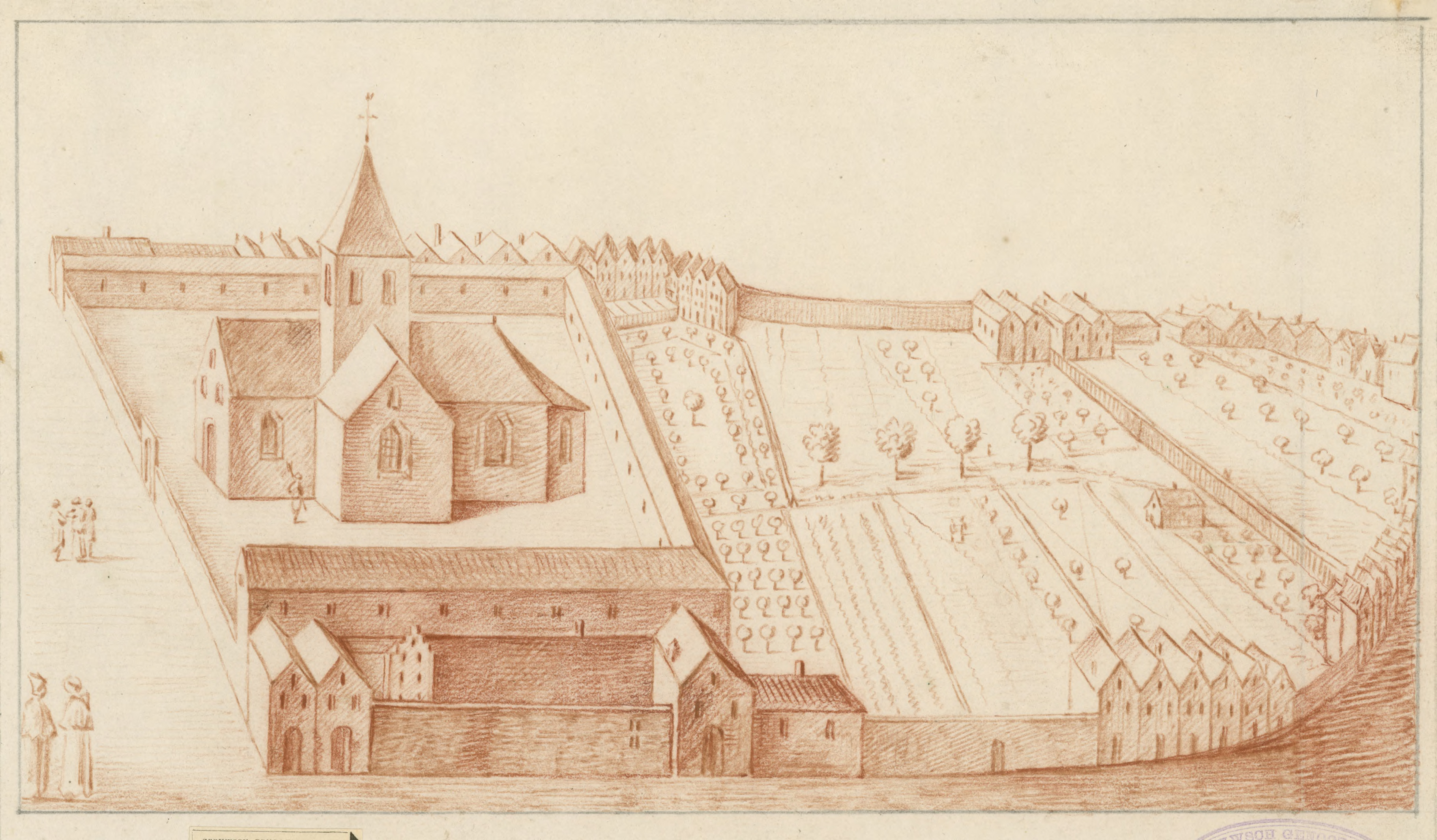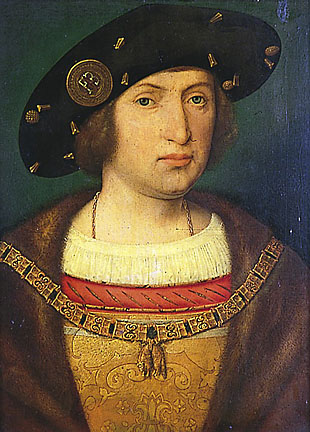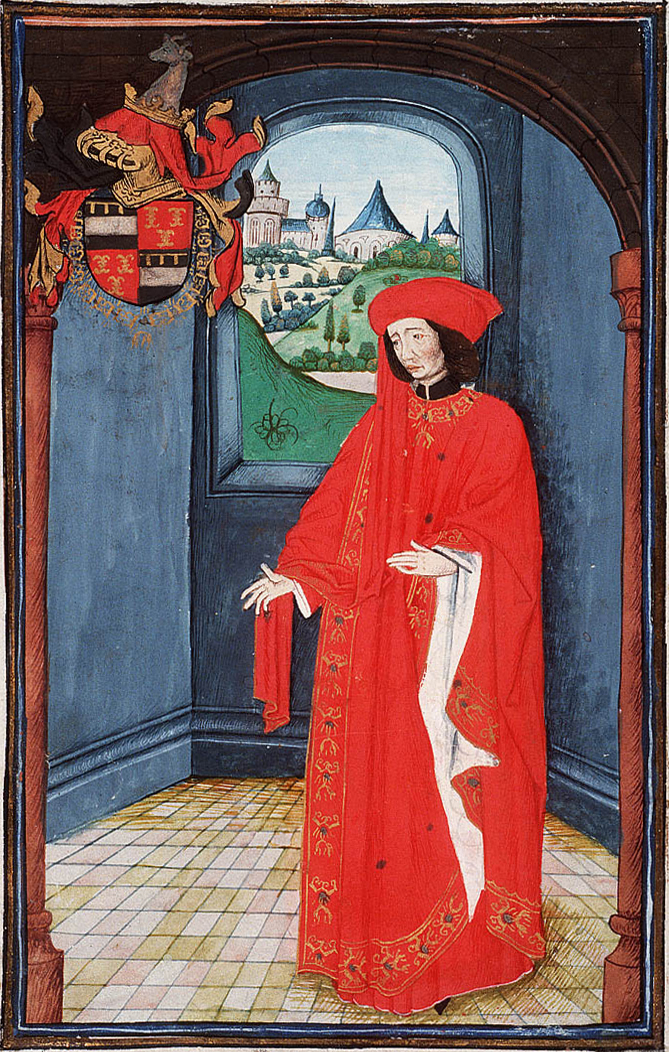|
Sint-Maartensdijk Castle
Sint-Maartensdijk Castle was a castle with a rich history. Except for a part of the moats nothing remains of it. Location and name The village Sint-Maartensdijk is located in the Oudelandpolder on the island Tholen. This is the oldest polder west of the Pluimpot, which is the old trench that used to split Tholen in two. The old map of Tholen shows Sint-Maartensdijk, the Oudelandpolder and the Pluimpot just southwest of its center. The Pluimpot used to be named Borden. Therefore, the oldest name of the area around Sint-Maartensdijk was Overbordene, meaning 'Over the Borden'. The village of Sint-Maartensdijk was previously named Haestinge. Some say this referred to a hare which is also on the old coat of arms of the village. Others say that Haestinge comes from 'Haast-Ee', another old name for the Pluimpot. Anyway, the inhabitants of Haestinge were mentioned as such in 1357. After 1357 a new church was founded dedicated to Martin of Tours, and the village was renamed according ... [...More Info...] [...Related Items...] OR: [Wikipedia] [Google] [Baidu] |
Sint-Maartensdijk
Sint-Maartensdijk is a village in the Dutch province of Zeeland. It is a part of the municipality of Tholen, and lies about 16 km west of Bergen op Zoom. History Sint-Maartensdijk was founded as 'Haestinge', and renamed when it got a church dedicated to Martin of Tours. The first lords of Sint-Maartensdijk resided at Sint-Maartensdijk Castle which was demolished in 1819. The castle was located just north of the town walls, and its southern moat is still visible. Sint-Maartensdijk was a separate municipality until 1971, when it was merged with Tholen. Born in Sint-Maartensdijk * Keetie van Oosten-Hage (born 1949), former cyclist * Cornelius Vermuyden (1595–1677), engineer *The Ghanaian politician Alfred Vanderpuije Alfred Oko Vanderpuije (born 4 November 1955) Newghana.org Alfred Vanderpuije Ed.S. is a Ghanaian educationist and politician who currently serves as a member of parliament. He is currently the member of parliament for Ablekuma South Constituency ... is d ... [...More Info...] [...Related Items...] OR: [Wikipedia] [Google] [Baidu] |
Claes I Van Borselen
Nicolas, Claes or Klaas van Borselen was a younger son of Wolfert I van Borselen. He founded the Van Borselen branch later known as Van Brigdamme. Family A younger son Claes was the fifth surviving son of Wolfert I van Borselen and his wife Sibilie. He was probably named after his great-grandfather Nicolas van Borselen. Unlike the other Van Borselens, this makes it easy to identify Claes. It is only in 1341 that a namesake, the child Claes son of Raas appears. Zeeland inheritance laws The County of Zeeland had different feudal inheritance laws than most other parts of the later Netherlands. Here all sons had an equal right to their parents' inheritance, instead of only the oldest son succeeding. Also, almost all the fiefs of Zeeland could only be inherited by sons, not by daughters, brothers, parents etc. This might explain why inherited fiefs often remained undivided for years. Life 1299: Claes' father is killed Claes' father Wolfert was killed in Delft on 1 August ... [...More Info...] [...Related Items...] OR: [Wikipedia] [Google] [Baidu] |
Leerdam
Leerdam () is a city and former municipality in the western Netherlands, in the province of Utrecht. The municipality was merged with the municipalities of Vianen and Zederik on 1 January 2019. The name of the new municipality is Vijfheerenlanden which is a part of the province Utrecht. The former municipality Leerdam was a part of the province South Holland. The south border of the town is formed by the river Linge. The name originates from a dam in the river Lede which was a branch from the river Linge towards Meerkerk. Leerdam is situated almost exactly in the middle of the three highways A2, A15 and A27. History Leerdam received city rights in 1407. The small river Linge, bordered by beautiful water meadows, defines the atmosphere and tone of the landscape. Several centuries ago Leerdam formed a part of the Vijfheerenlanden domain, before it was raised to the level of County in 1498. In 1551, Leerdam, together with Acquoy, became property of the House of Orange and part ... [...More Info...] [...Related Items...] OR: [Wikipedia] [Google] [Baidu] |
County Of Buren
The Buren County was a territory situated in what is now the Dutch province of Gelderland. It was an independent county until the establishment of the Batavian Republic in 1795. Although it was not formally part of the United Provinces, in practice it was governed by it. Lordship of Buren The Lordship of Buren was a result of the division of the county of Teisterbant in 994. The manor was owned by the van Buren family. Their coat of arms was also the Lordship's and the city's ones. The lordship's original fortress' Buren received city rights in 1395 by the knights Allard, Asch and Erichem; but through the acquisition, war and marriage, a number of villages were grown, including Beusichem, Zoelmond, Buurmalsen and Tricht. By this marriages policy, in 1472 the lordship's ownership went to the House of Egmond. County Buren was elevated to a county in 1498 by Emperor Maximilian of Austria. Later Charles V wanted to raise Buren to a duchy, but Maximilian of Egmond replied: "I'd ... [...More Info...] [...Related Items...] OR: [Wikipedia] [Google] [Baidu] |
Floris Van Egmont
Floris van Egmond (ca. 1470 – 25 October 1539) was count of Buren and Leerdam and Lord of IJsselstein and Sint Maartensdijk. He was stadtholder of Guelders (1507–1511) and Friesland (1515–1518) Floris was the son of Frederik van Egmond and Aleida van Culemborg. His career started in the 1490s as a chamberlord in the royal household of Philip I of Castile. After Philip's death, Floris gained a seat in the Court Council of Margaret of Habsburg, at the time the governor of the Netherlands. In 1505 he was knighted in the Order of the Golden Fleece. As a stadtholder of Guelders, he represented the Habsburg government in the parts of Guelders owned by Magaretha. In 1515 he became stadtholder of Friesland, when it was sold by George, Duke of Saxony to Habsburg. George of Saxony had failed to subdue Friesland during the Guelders Wars, and Floris controlled only a few cities (Leeuwarden, Harlingen and Franeker). Floris was also a commander in arms. In 1523, he was appointed comm ... [...More Info...] [...Related Items...] OR: [Wikipedia] [Google] [Baidu] |
Frederik Of Egmont
Frederik of Egmont (ca. 1440–1521) was count of Buren and Leerdam, Lord of IJsselstein and councilor of Charles the Bold and Maximilian I. Frederik was the second son of William II of Egmont and Walburga of Meurs. Together with his brothers, he participated in his father's campaign in the Duchy of Guelders. When Burgundy had conquered the Duchy, Frederik received some important functions there. In the 1480s he supported the policies of Maximilian I of Austria. He was present at Maximilian's coronation as Holy Roman Emperor in 1486, and led in 1488 an army against the city of Bruges that held Emperor Maximilian hostage. In 1492, Maximilian gave him the titles of ''Count of Buren'' and ''Count of Leerdam''. In 1499, he became a sworn member of the Illustrious Brotherhood of Our Blessed Lady in 's-Hertogenbosch s-Hertogenbosch (), colloquially known as Den Bosch (), is a city and municipality in the Netherlands with a population of 157,486. It is the capital of the provinc ... [...More Info...] [...Related Items...] OR: [Wikipedia] [Google] [Baidu] |
Philip The Good
Philip III (french: Philippe le Bon; nl, Filips de Goede; 31 July 1396 – 15 June 1467) was Duke of Burgundy from 1419 until his death. He was a member of a cadet line of the Valois dynasty, to which all 15th-century kings of France belonged. During his reign, the Burgundian State reached the apex of its prosperity and prestige, and became a leading centre of the arts. Philip is known historically for his administrative reforms, his patronage of Flemish artists such as van Eyck and Franco-Flemish composers such as Gilles Binchois, and perhaps most significantly the seizure of Joan of Arc, whom Philip ransomed to the English after his soldiers captured her, resulting in her trial and eventual execution. In political affairs, he alternated between alliances with the English and the French in an attempt to improve his dynasty's powerbase. Additionally, as ruler of Flanders, Brabant, Limburg, Artois, Hainaut, Holland, Luxembourg, Zeeland, Friesland and Namur, he played an i ... [...More Info...] [...Related Items...] OR: [Wikipedia] [Google] [Baidu] |
John III, Duke Of Bavaria
John III the Pitiless (1374–1425), of the House of Wittelsbach, was first bishop of Liège 1389–1418 and then duke of Bavaria-Straubing and count of Holland and Hainaut 1418–1425. Family John was born in Le Quesnoy. He was the youngest son of Duke Albert I of Bavaria and Margaret of Brieg. His elder brother was William II, who succeeded their father as count of Holland, Zeeland and Hainault in 1404. His sister, Margaret, married in 1385 Duke John the Fearless of Burgundy. Bishop As the youngest son of three, John was destined for a career in the church. At the age of 15, he became Prince-Bishop of Liège, with the support of Pope Boniface IX. John's rule was a disaster. His authoritarian style clashed with the nobles and burghers of the Prince-Bishopric. He was expelled several times and saw even a counter-bishop being elected. John turned for help to his brother and brother-in-law. On 23 September 1408, a Burgundian army led by his brother-in-law John the Fearle ... [...More Info...] [...Related Items...] OR: [Wikipedia] [Google] [Baidu] |
Frank Van Borssele
Frank II of Borssele (probably around 1396 – 19 November 1470, Den Briel) was a 15th-century Zeelandic nobleman. He was stadhouder of Holland and Zeeland, but is mainly known as the fourth husband of countess Jacqueline of Holland. He was the son of Floris van Borssele and Oda van Bergen, Lord of Sint Maartensdijk, Scherpenisse (both now districts of Tholen) and Zuylen. He was the last legitimate representative of the younger branch of the Borssele family. After succeeding her father, Jacqueline of Hainaut's authority was challenged by her uncle John III in the 1420s. In her place, her second husband John IV, Duke of Brabant appointed John III as ruler of Holland and Zeeland. From late 1421 to early 1423 Frank van Borssele played an essential role in the financial government of the county, as he was a loyal supporter of John III and Philip the Good, Duke of Burgundy. In 1422/23 he was alderman of Count John III and official governor of the country. The height of his powe ... [...More Info...] [...Related Items...] OR: [Wikipedia] [Google] [Baidu] |
Jacqueline, Countess Of Hainaut
Jacqueline ( nl, Jacoba; french: Jacqueline; german: Jakobäa; 15 July 1401 – 8 October 1436), of the House of Wittelsbach, was a noblewoman who ruled the counties of Holland, Zeeland and Hainaut in the Low Countries from 1417 to 1433. She was also Dauphine of France for a short time between 1415 and 1417 and Duchess of Gloucester in the 1420s, if her marriage to Humphrey, Duke of Gloucester, is accepted as valid. Jacqueline was born in Le Quesnoy and from her birth she was referred to as "of Holland", indicating that she was the heiress of her father's estates. Jacqueline was the last Wittelsbach ruler of Hainaut and Holland. Following her death, her estates passed into the inheritance of Philip the Good, Duke of Burgundy. Life Early life and marriage to John, Duke of Touraine She was the only daughter of William II, Duke of Bavaria (also known as William VI, Count of Holland) from his marriage with Margaret, a daughter of Philip the Bold, Duke of Burgundy and Margaret ... [...More Info...] [...Related Items...] OR: [Wikipedia] [Google] [Baidu] |
Zuylen Castle
Zuylen Castle (Dutch: ''Slot Zuylen'' - ) is a Dutch castle at the village of Oud-Zuilen just north of the city of Utrecht. It is located along the river Vecht at the southern end of the Vechtstreek. The castle was originally built in the 13th century by lord van Suilen en Anholt as a simple donjon. In 1422 during the Hook and Cod wars the castle was completely demolished. In 1510 rebuilding started. In 1752 the castle was modified for the last time. It holds a tapestry by the Delft carpet weaver Maximiliaan van der Gught. Its past inhabitants include Steven van der Hagen and Belle van Zuylen. Image:Zuylen.jpg, Slot Zuylen with serpentine wall A crinkle crankle wall, also known as a crinkum crankum, sinusoidal, serpentine, ribbon or wavy wall, is an unusual type of structural or garden wall built in a serpentine shape with alternating curves, originally used in Ancient Egypt, bu ... Image:Slangenmuur.jpg, Serpentine wall (for fruits) Image:Toegangspoort.jpg, Entrance ... [...More Info...] [...Related Items...] OR: [Wikipedia] [Google] [Baidu] |





